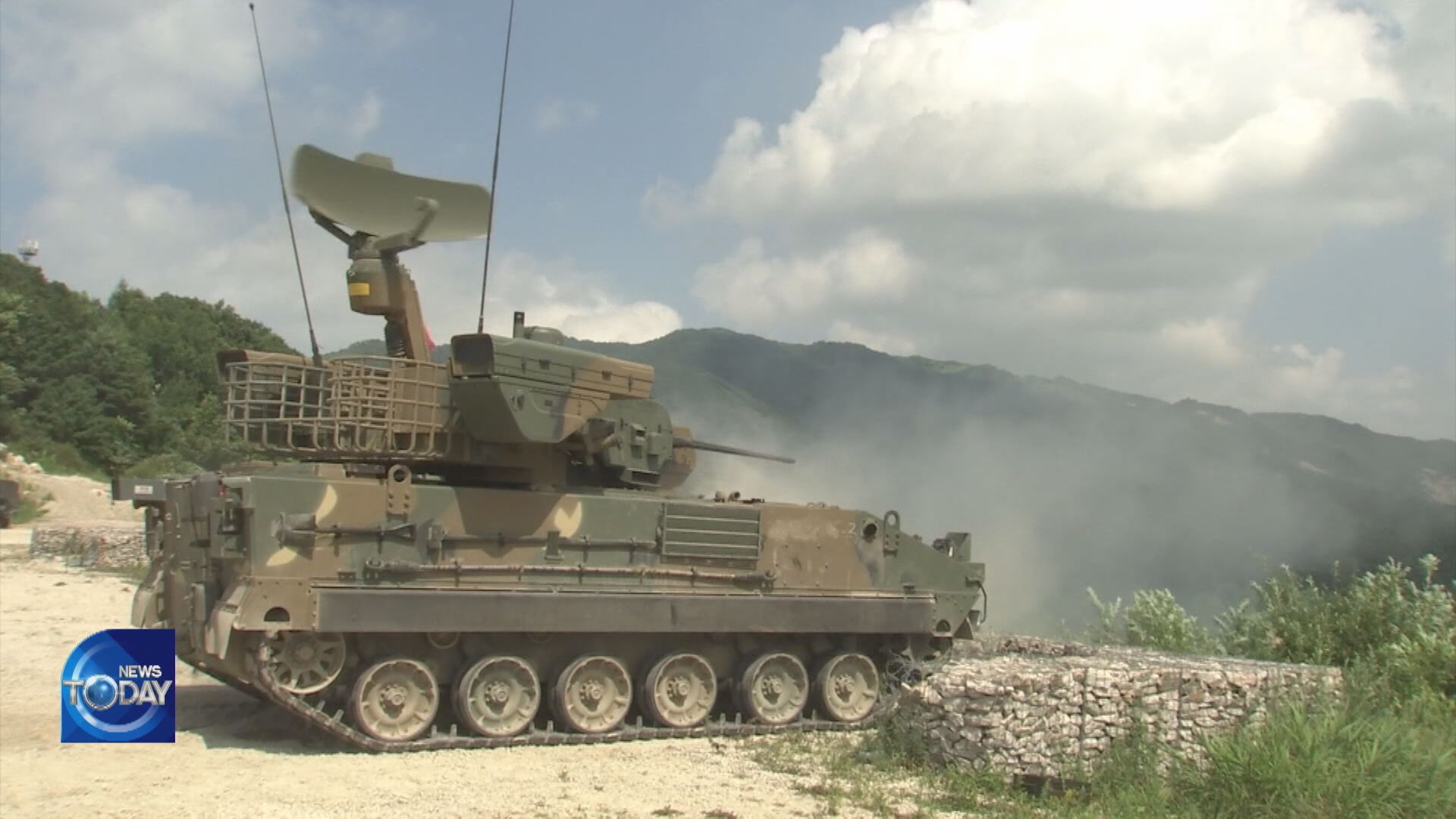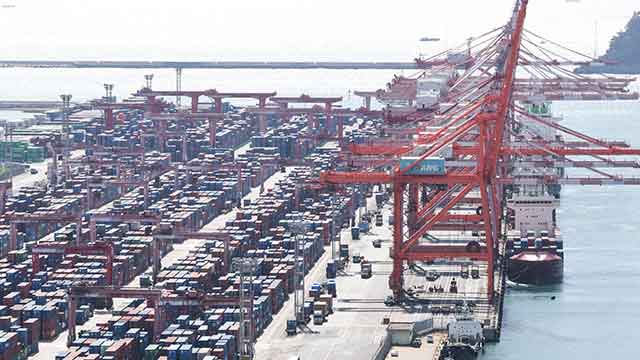CARBON EMISSIONS BY THE MILITARY
입력 2022.08.05 (15:05)
수정 2022.08.05 (16:45)
읽어주기 기능은 크롬기반의
브라우저에서만 사용하실 수 있습니다.
[Anchor Lead]
Eight years are left before Korea is to achieve its goal to cut carbon emissions by 40 percent. Efforts to reduce carbon emissions are being exerted across industries, but the military sector has long remained in the shadows due to confidentiality issues. An environmental group has for the first time made the military disclose its carbon emissions.
[Pkg]
From helicopters to tanks and artillery, most of the weapons and equipment used in the military are powered by fossil fuel. So, how much carbon does the military emit? Data released by the defense ministry for the first time ever says carbon emissions in the military reaches 3.88 million tons. That's 1.7 percent of overall greenhouse gas emissions in the nation. It's equivalent to the amount of emissions produced by 2.5 million vehicles travelling 15,000 km for a year. In 2020, government ministries and 783 public sector areas emitted 3.7 million tons of carbon. In other words, carbon emissions in the military exceeds those of the entire public sector. However, the country's military operations is not subject to carbon regulations, except for some of its facilities. It's exempt due to confidentiality of national security and defense issues.
[Soundbite] Hwang In-chul(Green Korea) : "The climate crisis poses threat to national security. The military cannot be excluded from climate response."
In the U.S., in contrast, measuring greenhouse gas emissions in the military every year is required by law. The U.S. also plans to switch non-tactical vehicles to electric vehicles. Europe also has policies in place to measure and track emissions produced by the military. Their military sectors are included in their overall carbon neutrality scheme.
[Soundbite] Yoon Se-jong(Environmental group ‘Plan 1.5’) : "To achieve carbon neutrality, the entire society must reduce emissions, and the defense sector is not an exception for obvious reasons. We need to devise emission reduction strategies specifically for the military and implement them."
Only eight years are left before the deadline for the first stage of the carbon neutrality plan. Accurate measurement and reduction of carbon emissions is essential for achieving carbon neutrality. That's why many say the military should also be subject to greenhouse gas regulations.
Eight years are left before Korea is to achieve its goal to cut carbon emissions by 40 percent. Efforts to reduce carbon emissions are being exerted across industries, but the military sector has long remained in the shadows due to confidentiality issues. An environmental group has for the first time made the military disclose its carbon emissions.
[Pkg]
From helicopters to tanks and artillery, most of the weapons and equipment used in the military are powered by fossil fuel. So, how much carbon does the military emit? Data released by the defense ministry for the first time ever says carbon emissions in the military reaches 3.88 million tons. That's 1.7 percent of overall greenhouse gas emissions in the nation. It's equivalent to the amount of emissions produced by 2.5 million vehicles travelling 15,000 km for a year. In 2020, government ministries and 783 public sector areas emitted 3.7 million tons of carbon. In other words, carbon emissions in the military exceeds those of the entire public sector. However, the country's military operations is not subject to carbon regulations, except for some of its facilities. It's exempt due to confidentiality of national security and defense issues.
[Soundbite] Hwang In-chul(Green Korea) : "The climate crisis poses threat to national security. The military cannot be excluded from climate response."
In the U.S., in contrast, measuring greenhouse gas emissions in the military every year is required by law. The U.S. also plans to switch non-tactical vehicles to electric vehicles. Europe also has policies in place to measure and track emissions produced by the military. Their military sectors are included in their overall carbon neutrality scheme.
[Soundbite] Yoon Se-jong(Environmental group ‘Plan 1.5’) : "To achieve carbon neutrality, the entire society must reduce emissions, and the defense sector is not an exception for obvious reasons. We need to devise emission reduction strategies specifically for the military and implement them."
Only eight years are left before the deadline for the first stage of the carbon neutrality plan. Accurate measurement and reduction of carbon emissions is essential for achieving carbon neutrality. That's why many say the military should also be subject to greenhouse gas regulations.
■ 제보하기
▷ 카카오톡 : 'KBS제보' 검색, 채널 추가
▷ 전화 : 02-781-1234, 4444
▷ 이메일 : kbs1234@kbs.co.kr
▷ 유튜브, 네이버, 카카오에서도 KBS뉴스를 구독해주세요!
- CARBON EMISSIONS BY THE MILITARY
-
- 입력 2022-08-05 15:05:30
- 수정2022-08-05 16:45:04

[Anchor Lead]
Eight years are left before Korea is to achieve its goal to cut carbon emissions by 40 percent. Efforts to reduce carbon emissions are being exerted across industries, but the military sector has long remained in the shadows due to confidentiality issues. An environmental group has for the first time made the military disclose its carbon emissions.
[Pkg]
From helicopters to tanks and artillery, most of the weapons and equipment used in the military are powered by fossil fuel. So, how much carbon does the military emit? Data released by the defense ministry for the first time ever says carbon emissions in the military reaches 3.88 million tons. That's 1.7 percent of overall greenhouse gas emissions in the nation. It's equivalent to the amount of emissions produced by 2.5 million vehicles travelling 15,000 km for a year. In 2020, government ministries and 783 public sector areas emitted 3.7 million tons of carbon. In other words, carbon emissions in the military exceeds those of the entire public sector. However, the country's military operations is not subject to carbon regulations, except for some of its facilities. It's exempt due to confidentiality of national security and defense issues.
[Soundbite] Hwang In-chul(Green Korea) : "The climate crisis poses threat to national security. The military cannot be excluded from climate response."
In the U.S., in contrast, measuring greenhouse gas emissions in the military every year is required by law. The U.S. also plans to switch non-tactical vehicles to electric vehicles. Europe also has policies in place to measure and track emissions produced by the military. Their military sectors are included in their overall carbon neutrality scheme.
[Soundbite] Yoon Se-jong(Environmental group ‘Plan 1.5’) : "To achieve carbon neutrality, the entire society must reduce emissions, and the defense sector is not an exception for obvious reasons. We need to devise emission reduction strategies specifically for the military and implement them."
Only eight years are left before the deadline for the first stage of the carbon neutrality plan. Accurate measurement and reduction of carbon emissions is essential for achieving carbon neutrality. That's why many say the military should also be subject to greenhouse gas regulations.
Eight years are left before Korea is to achieve its goal to cut carbon emissions by 40 percent. Efforts to reduce carbon emissions are being exerted across industries, but the military sector has long remained in the shadows due to confidentiality issues. An environmental group has for the first time made the military disclose its carbon emissions.
[Pkg]
From helicopters to tanks and artillery, most of the weapons and equipment used in the military are powered by fossil fuel. So, how much carbon does the military emit? Data released by the defense ministry for the first time ever says carbon emissions in the military reaches 3.88 million tons. That's 1.7 percent of overall greenhouse gas emissions in the nation. It's equivalent to the amount of emissions produced by 2.5 million vehicles travelling 15,000 km for a year. In 2020, government ministries and 783 public sector areas emitted 3.7 million tons of carbon. In other words, carbon emissions in the military exceeds those of the entire public sector. However, the country's military operations is not subject to carbon regulations, except for some of its facilities. It's exempt due to confidentiality of national security and defense issues.
[Soundbite] Hwang In-chul(Green Korea) : "The climate crisis poses threat to national security. The military cannot be excluded from climate response."
In the U.S., in contrast, measuring greenhouse gas emissions in the military every year is required by law. The U.S. also plans to switch non-tactical vehicles to electric vehicles. Europe also has policies in place to measure and track emissions produced by the military. Their military sectors are included in their overall carbon neutrality scheme.
[Soundbite] Yoon Se-jong(Environmental group ‘Plan 1.5’) : "To achieve carbon neutrality, the entire society must reduce emissions, and the defense sector is not an exception for obvious reasons. We need to devise emission reduction strategies specifically for the military and implement them."
Only eight years are left before the deadline for the first stage of the carbon neutrality plan. Accurate measurement and reduction of carbon emissions is essential for achieving carbon neutrality. That's why many say the military should also be subject to greenhouse gas regulations.
이 기사가 좋으셨다면
-
좋아요
0
-
응원해요
0
-
후속 원해요
0

















이 기사에 대한 의견을 남겨주세요.